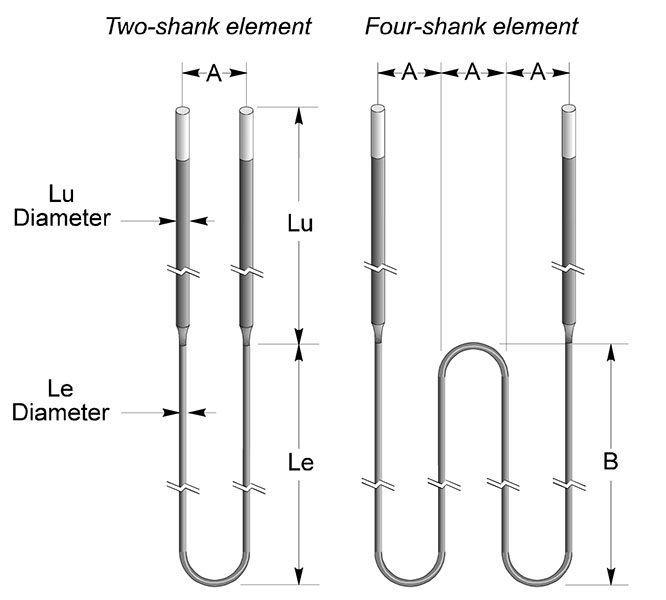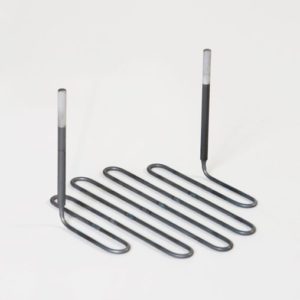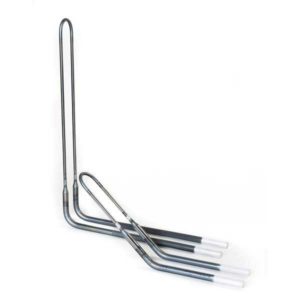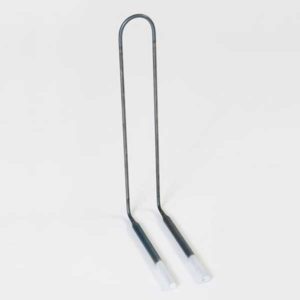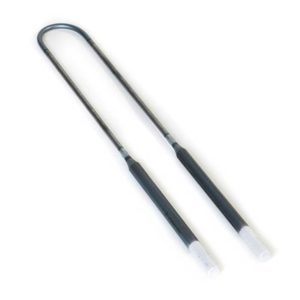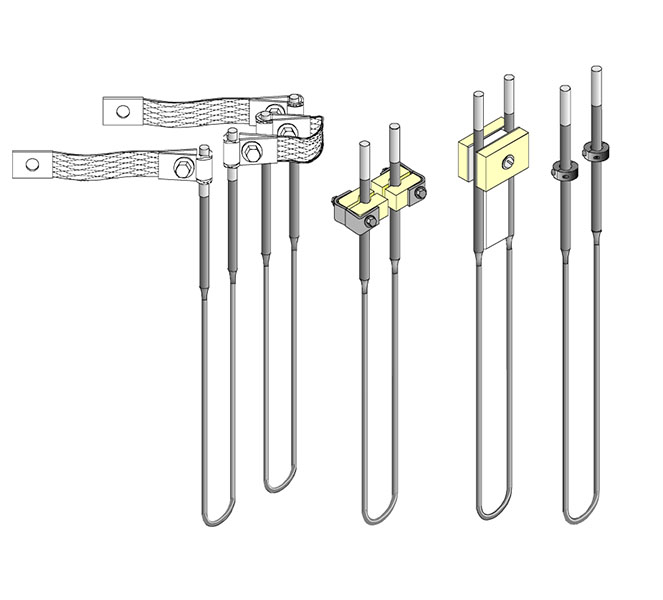The Moly-D element is a dense cermet material consisting of MoSi2 and an oxide, glassy phase component.
Moly-D elements have the ability to withstand oxidation at high temperatures by forming a protective layer of quartz on its surface. If this glassy phase should be exposed to contaminants, a lower melting phase forms. This material literally drips off the element exposing more molybdenum disilicide on which a new protective oxide layer forms.
Moly-D elements become somewhat ductile at approximately 1200ºC (2190ºF).
Moly-D Technical Brochure
(PDF, 3739KB)
Moly-D Spec Worksheet
(PDF, 384KB)
Moly-D Installation Instructions
(PDF, 25KB)
Specifications
Unique Properties
- Moly-D elements may be used up to a surface temperature of 1800ºC (3270°F) in oxidizing atmospheres.
- Long service life and ease of replacement contribute to high furnace utilization and low maintenance costs.
- New and old elements can be used together and in series.
- Can dissipate high power loading.
- Can be used continuously or intermittently.
- Provide rapid furnace temperature ramping.
Grades
Type MD-31
- Maximum Element Temperature – 1700°C (3090°F)
- General Applications — Most types of industrial furnaces for heat treating, forging, sintering, glass melting and refining, and for use in radiant tubes.
Type MD-33
- Maximum Element Temperature – 1800°C (3270°F)
- General Applications – Laboratory furnaces, testing equipment, and high temperature sintering production furnaces.
Made to Industry Standards
Moly-D heating elements are manufactured to industry established resistance values. The same spacing, power ratings and voltages, used with other molybdenum disilicide elements can be used.
Delivery
Most sizes and types can be shipped 2 to 3 weeks after receipt of an order. Emergency shipments for 3/6 and 6/12 can usually be made in 2 to 3 days.
Technical Assistance
We can assist you in choosing the most suitable element material and element type for your application. We also offer free engineering service for a new furnace design or a conversion from gas or oil fired to electric heating.
Moly-D Accessories
Straps and holders are available for all sizes.
Available Sizes
| TABLE B | ||||||
| SIZES AVAILABLE | ||||||
| Size | Heating Zone Le Ø | Terminal End Lu Ø | Standard “A” Distance | |||
| mm | in | mm | in | mm | in | |
| 3/6 | 3 | .12 | 6 | .24 | 25 | .98 |
| 4/9 | 4 | .16 | 9 | .35 | 25 | .98 |
| 6/12 | 6 | .24 | 12 | .47 | 50 | 1.97 |
| 9/18 | 9 | .35 | 18 | .71 | 60 | 2.36 |
| 12/24 | 12 | .47 | 24 | .94 | 80 | 3.15 |
All diameters are available in the following grades: Grade MD-31 – maximum element temperature 1700ºC (3090ºF) Grade MD-33 – maximum element temperature 1800ºC (3270ºF) |
||||||
Multi-shank elements
For applications where the vertical height of the hot chamber is small, the use of horizontally mounted elements can be used. In such cases, four-shank or multi-shank elements may be used. The surface temperature of the element must not exceed 1600ºC.
Engineering Information
Physical Characteristics
Moly-D heating elements are manufactured by powder metallurgy. They consist of molybdenum disilicide with additives that prevent recrystallization. Since Moly-D is completely stable up to 1800ºC (3270°F), it surpasses other heating element types for high temperature performance.
The resistance of Moly-D elements to oxidation lies in the formation of an impermeable quartz, or glass-like protective layer which re-forms when heated if damaged in operation.
The Moly-D element has a low specific electrical resistivity with a positive resistance-temperature characteristic. It can be used at a very high watt loading compared to metallic heating elements. Because of its high temperature oxidation resistance, Moly-D electrical resistance remains constant at constant temperature over its useful life. This permits the use of old and new elements together in the same furnace, even if series-connected.
Temperature Range
Maximum element temperature depends on the atmosphere within the furnace chamber. In air this is 1800ºC (3270°F). Since element surface temperature exceeds furnace ambient in relation to the watt loading, careful attention must be given to these parameters for satisfactory element performance.
Moly-D heating elements normally operate between 1300 and 1750ºC (2372-3182°F). Moly-D elements may be used below 1300ºC (2372°F) particularly for furnace atmospheres harmful to silicon carbide heating elements (e.g., sulfur dioxide, water-steam, etc.). Moly- D should not be used between the temperature range of 400 and 700ºC (752-1292°F), where a destructive low temperature oxidation may occur called pest.
Element Type and Dimensions
Moly-D heating elements may be made in a variety of configurations. Most common is a two shank (U-shaped) element having terminal ends twice the diameter of the heating section. Since the cross sectional area of the terminal ends is four times that of the heating section, the exposed terminal ends operate at a low enough temperature to require no supplemental cooling if proper design criteria are used.
Four-shank-elements in the 6/12, 9/18 and 12/24 diameters are also available. They are normally used in furnaces with a low chamber height where the elements would be mounted horizontally.
REQUEST INFORMATION


